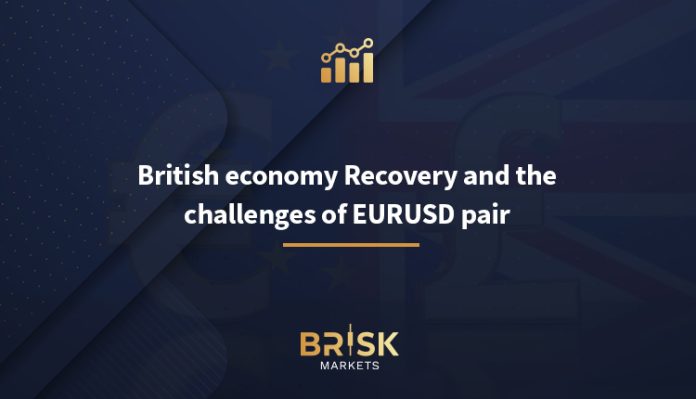
Statistics from the National Authority for Statistics (ONS) reported today, Friday, that the British economy has emerged from recession, as the country’s gross domestic product witnessed a growth of 0.6% on a quarterly basis during the first three months of the current year, which is an indication of a return to the growth path after a slight decline in… Second half of 2023. This figure exceeds market expectations of a 0.4% expansion in the first quarter. In this context, Jendos, an official at the European Central Bank, confirmed that the bank will not make a commitment regarding the path of interest rate cuts planned for June.
Furthermore, UK GDP recorded an expansion of 0.2% year-on-year in the first quarter of 2024, after a contraction of 0.2% in the fourth quarter of 2023. This accelerated growth is due to a level above the expected average of 0%. The British pound received a positive response to these encouraging data, attracting more buyers and causing fluctuations in the EUR/GBP pair.
On Thursday, the Bank of England decided to keep interest rates at 5.25% for the sixth time in a row, which opens the door to the possibility of lower interest rates in the near future than expected. During the press conference, Andrew Bailey, Governor of the Bank of England, indicated that an interest rate cut next month may be possible, but stressed that it would be based on inflation data, economic activity and the state of the labor market before making a final decision.
Hugh Bell, chief economist at the Bank of England, explained that the British Central Bank feels confident that it can begin to ease monetary policy during the upcoming meetings, and with regard to the euro, Louis de Gendos, Vice President of the European Central Bank, announced that the bank will not commit to any developments after the reduction. Interest rates scheduled for June.
EURUSD challenges: rate cut expectations and market volatility
The EURUSD pair maintains its gains near the 1.0776 level, in light of expectations of interest rate cuts by the Federal Reserve, which makes the US dollar face major challenges.
The EURUSD pair continues to trade within a narrow range, near the crucial level of resistance at 1.0785, during the European market session on Friday, after rising sharply from the 1.0723 level. The major pair remains strong, as investors have already ruled out the hypothesis that the European Central Bank will start cutting borrowing rates in June.
The EURUSD pair was affected this week by a decline in activity in key economic data in the Eurozone and the United States, which affected market sentiment. However, investors will focus next week on the US CPI data for April, which will be released on Wednesday.
European Central Bank policymakers face a split over how long to continue a series of interest rate cuts after the June meeting. A few policymakers believe that additional interest rate cuts starting at the July meeting could lead to further pressure on the prices of goods and services.
European Central Bank policymaker and Bank of Greece Governor Yannis Stournaras also said in an interview with a Greek media outlet last week that he expects three interest rate cuts this year. He sees an interest rate cut in July as possible, and added that the economic recovery in the first quarter made a three-cut scenario more likely than four. The eurozone economy grew by 0.3% in the January-March period, beating expectations for 0.1% growth.
On the other hand, European Central Bank Governing Council member and Austrian Central Bank Governor, Robert Holzmann, expressed that he sees no reason to cut key interest rates “too quickly or too aggressively” at the present time.
In the end, the EURUSD pair remains under observation, as tensions and volatility continue in the market, and economic data and central bank decisions remain determinant of the pair’s trends in the near future.
Increased expectations of interest rate cuts due to the slowdown in the US labor market
The EURUSD pair is in the market portfolio today with sustained strength, as it benefits from improved sentiment in the financial arena. The pair is showing little strength at the 1.0785 resistance level, trading at 1.0776, thanks to investor optimism and increased demand for riskier assets, with strong expectations that the Federal Reserve will start cutting interest rates in September. In the European trading session, S&P 500 futures posted significant gains, reflecting investors’ appetite for more risk.
Expectations are rising that the Federal Reserve will cut interest rates in September, with signs of a slowdown in the US labor market. The US Department of Labor reported that the number of initial unemployment claims rose significantly to 231,000 (the highest level since the 10th week of November), exceeding consensus expectations of 210,000 and the previous reading of 209,000.
In addition, other than unemployment claims exceeding expectations, a weak April non-farm payrolls report and a decline in hiring opportunities in March weakened investor confidence in the strength of the US labor market. The growth rate in job opportunities recorded its lowest level in six months, and job advertisements fell to the lowest level in three years.
The harsh economic conditions in the US labor market reflect the difficulty of sustaining the Federal Reserve’s restrictive monetary policy measures. This context has increased expectations of interest rate cuts by the Federal Reserve in September. Traders view the probability of interest rates being cut at their current numbers in September at 71%, higher than the 66% recorded a month ago.
This week, the Federal Reserve Chairman suggested that a weak labor market could be a justification for cutting interest rates. Despite this, the bank remains inclined to maintain current interest rates throughout the year, highlighting concerns about slowing inflation, which has fallen to 2%, in addition to the strong real estate market.














